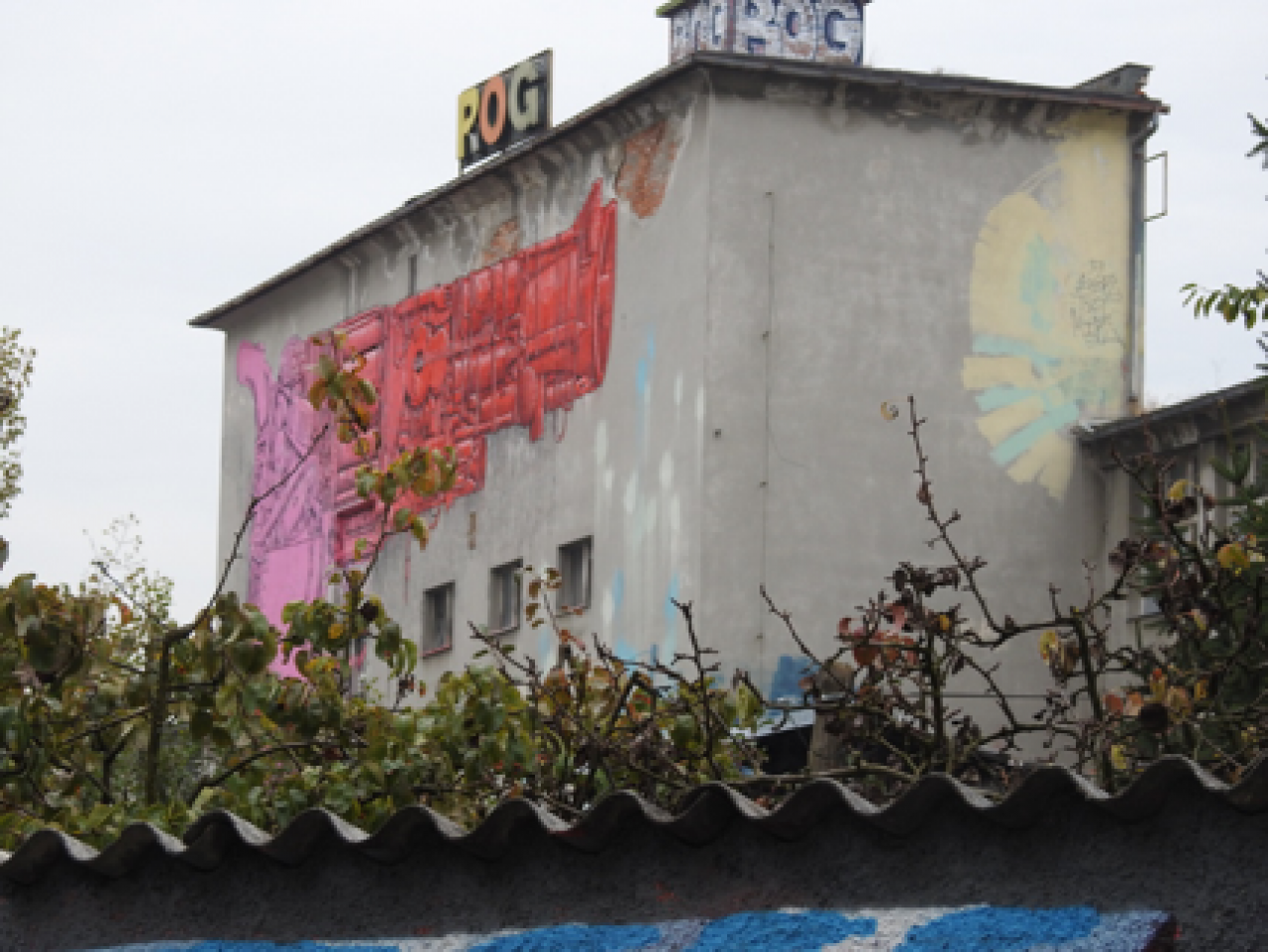
During their 100-150 years of history industrial (or in a broader sense, non-residential) buildings face many challenges. Not only technology may change but whole industries might become outdated and shut down. Moreover there is a spatial factor: a factory built on the periphery of a small settlement might find itself a few decades later in the centre of the expanding city, occupying areas with much higher land value than justified for industrial use.
The problems of such outdated industrial places, the conflicts and their potential solutions have large relevance for many ongoing URBACT Action Planning Networks, such as Second Chance (dealing with re-use of abandoned large buildings), Refill (focusing on temporary use), Sub>urban (exploring new approaches to transition zones of cities), Maps (discussing options for former military sites). For all of these URBACT networks the story of the Rog factory in Ljubljana is interesting, as it highlights most of the key aspects and dilemmas of abandoned industrial places, while also confronting with each other the most important approaches to find solutions.
The 150 years’ history of the (former bike-producing) Rog factory can be summarized as follows.
- During the second half of the 19th century, the first premises were built for manufacturing in the area which is on the river and close to the city centre.
- The factory increased production until its nationalisation shortly after WWII. The further expanding factory, after several successful decades, ceased to operate in 1991, when industrial production was shifted further out from the city centre and the whole place was abandoned.
- The main factory building became protected as an industrial heritage site in 1998. After a short-lived privatization in 2002 the municipality bought the entire 7000 sqm industrial complex.
- Apart from two large scale exhibitions nothing happened in the empty-standing industrial area until 2006, when an informal interdisciplinary group of young people decided to take the initiative into their own hands.
This is a familiar story: abandoned industrial area with heritage-protected buildings in a good location close to city centre, getting into the cross-roads of conflicting interests of the public sector, private developers and civil organizations. Before going into the details a few pictures help to visualize the case.
Pictures 1-2: The Rog factory is the long building (and the smaller buildings behind it) in the middle of Picture 1, on the river Ljubljanica, one km from the center of Ljubljana. Picture 2 shows the façade facing the river. Sources: tylerarch4431.blogspot.hu and Ivan Tosics
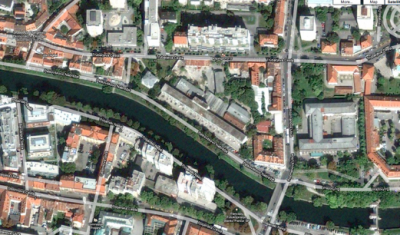
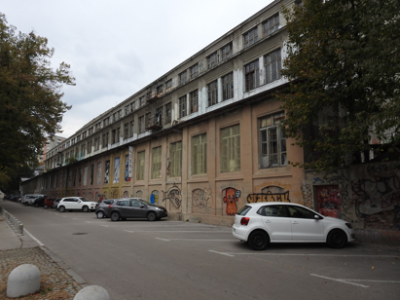
Pictures 3-4: The façade of the Rog factory, with hints to the past (producing bikes). Source: Ivan Tosics
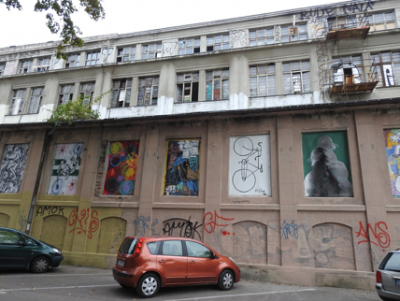

Pictures 5-6: Opposite to the Rog factory a high quality residential development, facing the wall and the entrance to Rog. Source: Ivan Tosics
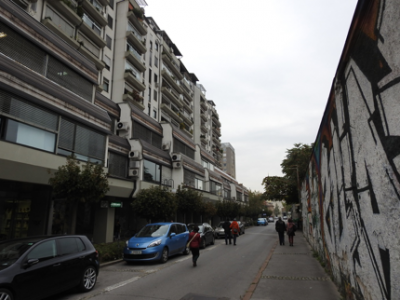

In each of such cases there are (at least) two different stories: how the situation is understood and described from the perspective of the occupant community versus from the viewpoint of the municipality.
The perspective of the occupant community
The story started in March 2006 with a plan for a two-week festival by a coalition of individuals, independent groups and the Faculty of Architecture of University of Ljubljana to showcase the potential uses of the space, which stood empty already for 15 years by that time. After everything was prepared, a day before the announced start of the festival, the municipality announced not to allow the festival to happen. The community decided that despite this they would proceed with the planned activities and instead of just two weeks they would occupy the space until the municipality found a better use of the abandoned factory. From that moment on the former factory has been occupied by the community, keeping it open to the public with the intent to carry out non-profit, non-established activities on its premises. The transition from a factory to a cultural centre was not a classic squatting occupation, but an attempt to create new types of temporary use.
The occupiers met several times with the representatives of the city in 2007, preparing a contract about temporary use of the Rog factory premises. However, when a mutually acceptable contract was finalized, the mayor refused to sign it. From that moment on the occupation continued with no hope to link the premises to the basic infrastructure systems (electricity, water, sewage) of the city. Still today electricity is only available from portable electric generators, the use of which is quite expensive and cumbersome. Not all spaces and collectives have access to electricity and heating is also hugely problematic.
Despite the difficulties, the users secured and cleaned the spaces and established ateliers, workshops, galleries, skate-park, concert hall, recreational facilities and social centre in the factory premises. In the course of these artistic, entertainment and sport activities efforts were taken to include disadvantaged people, migrants and asylum seekers through organizing community kitchen, language courses, etc. Without any help from the municipality the users created one of the main locations of urban culture, critical thinking and political activism in the city. Today, there are around 15 organised collectives and around 15 individuals active in the factory in 30 spaces that are relatively self-sufficient and autonomous. The community is bound together through the assembly which is the main political body following the principle of direct-democracy in decision making.
Pictures 7-8: The inner courtyard with the main building in the back, featuring a famous wall painting. Source: Ivan Tosics
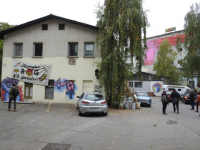

Pictures 9-10: Three of the leading persons of the occupier community explain the story to visitors, continued by a discussion in the ‘social center’. Source: Ivan Tosics

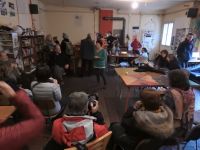
Pictures 11-12: Premises for literature and philosophical discussions and the theatre room. Source: Ivan Tosics
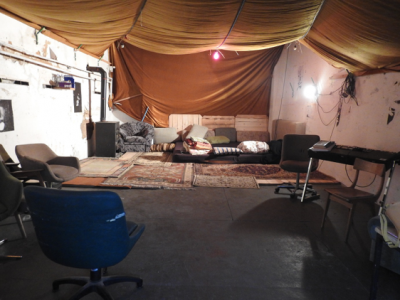
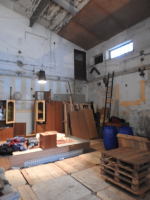
Pictures 13-14: Premises for bike-repair and for sport activities. Source: Ivan Tosics
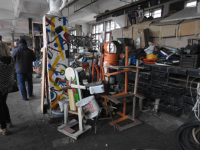
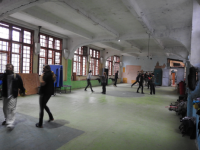
The ideas of the municipality
Since 2007 the municipality developed plans to renovate the spaces and turn them into a hub for contemporary art and creative industries. The main (protected) building has been planned to be transformed into the Rog Contemporary Arts Center with a production center, exhibition spaces, studios and artist-in-residence programmes, art shops, educational spaces, etc. In order to create an attractive area for international artists and tourists the first idea was to establish a public-private partnership, renovating the main factory building, demolishing all other buildings, replacing these with a 40 m high design hotel, high standard apartments and commercial facilities. The public to private ratio was planned to be 20% to 80%.
However, due to the financial crisis the municipality was not able to find any private investors. Around 2013 the Public Private Partnership plans were dropped and the idea of a publicly financed “centre for architecture, design and visual arts” was emerging, to develop the creative industries and help young designers to enter the labour market. The planned premises for creative industry and culture would be surrounded by a park. Later also the idea for a library and productive spaces was raised and the occupants were offered to be included into the project, to the extent of their need for space.
Pictures 15: One of the entries for the ‘Rog Art Centre’ architectural competition, raised by Ljubljana Municipality in 2007. Source: mx-si.net

The antagonistic conflict between the grassroots arguments and the plans of the municipality
Since 2013 the community of users was invited to the discussions about the plans of the municipality. However, the community evaluated these occasions as being invited in the role of a subordinated partner, as all the major parameters of the municipalities’ plan were already fixed before the discussions. The municipality did a SWOT analysis, etc. but in the community’s opinion never wanted to understand what the expectations of the users are.
The community of Rog users discussed many times the plans of the municipality and raised the following critical points.
- The project is financially very demanding – the municipality doesn’t possess enough funds to realize the project, while it has not yet applied for EU funds. The most likely outcome is that the municipality will not be able to do the renovation project and there will be another long-term construction pit in Ljubljana.
- The project is in fact unnecessary: enough creative hubs exist already in Ljubljana with developed social and business networks that the municipality could support instead of establishing new facilities.
- The planned renovation would lead to commodification of artistic and cultural practices and would contribute to the further gentrification of the city centre by beautification of space, and shift of focus from citizens to tourists and consumers.
- The municipal plans show strong aversion against grassroots practices. In the typical top-down process the current users were never included in the concept-formation stage of the renovation project and were used only for testing the already developed plans and proposals. The occupiers were only allowed to give opinions and suggestions, which were not thoroughly considered and included into the municipal plan.
The ideas of the two sides are in many regards very different from each other. The municipality talks about holistic renovation – understanding high level physical renovation, regardless on the existing content and people, who are present on the spot already since 10 years. If large renovation was carried out, only a small part of the existing community could find space, many of the current users would not be able to remain in the renovated centre. The suggestion of the user community is very different: to do renovation in small, incremental steps, always with regard to the needs of the groups already present. In such a heterogeneous place no one big project should be pushed through but a process should be launched to mitigate the different ideas of the different groups which are present since long. A complex negotiation process would be needed.
The position of the users/occupiers of Rog is based on the ‘Right to the city’ argument: after ten years of working in precarious conditions, regenerating the area and producing cultural content in public interest, this community has a legitimate right to use and manage the property even if it is not in its possession legally. On that basis they demand the municipality to step back from their earlier proposals, and recognize the potentials of the existing activities and organisational structure. The municipality should provide the minimum infrastructure and basic services, should perform the renovation of the protected facade, the restoration of the windows, should solve stability problems and the removal of the roof panels containing asbestos. The users, on the other hand, are capable to continuously carry out further self-renovation of the buildings (a lot of insulation was already done, with materials donated or gotten from construction sites), can provide new contents and self-manage the already existing and well-functioning creative factory Rog.
The sharpening of the conflict: the eviction attempt
Despite not obtaining private partnership funding to start with the renovation process, the municipality decided to start with construction and on 6 June 2016 construction workers entered the space with an excavator. The workers were confronted by the users and the conflict escalated into violence and clash with security guards. Through this action the municipality established a construction site, preventing its construction permit to expire. However, occupants reacted fast and soon after the initial attack few hundred people successfully resisted the violence. Barricades were built and after a few hours security forces and the police were pushed out of the factory – thus eviction and demolition was avoided.
Before the attempt to evict the occupiers the entry gate to the premises was under the control of a security company. This has changed after the attack, the occupiers did not allow the security guards to return and took the control over the entry into their own hands. With this the temporary use of the space turned into a real squatting.
The occupiers emphasized their willingness for a dialogue with the municipality – offering the assembly of the autonomous Rog Factory users as partner in the dialogue, since the assembly de facto controls the area and has the power to normalize the tense situation.
The municipality turned to the court against the occupiers. The court decision gave the occupiers some time: they are safe (for probably one year) until a decision on the ownership is reached. The municipality launched individual property ownership lawsuits (for 200 000 euros each) against 8 people occupying the buildings which are in the worst condition. Thus not the whole project is discussed but the municipality fights against the weakest parts. If the municipality wins some of the lawsuits, rebuilding will start.
Discussion and outlook
The occupation of the Rog factory started as a temporary use initiative and after 10 years it turned into a squat. It is an important aspect that activities always aimed for cultural and artistic use of the industrial premises, not for residential use of it.
There is an increasing literature which considers empty or heavily underused public spaces as commons. Such places offer the possibility of a third type of ownership and management of space (especially in regard of cultural functions): ‘community use’ as opposed to the exclusive public or private forms. As James B. Quilligan puts it in Why Distinguish Common Goods from Public Goods?: „Unlike commercial delivery chains or the bureaucratic provision of public goods and services by the state, the autonomy of individual choice is best assured through the cooperative production of value and governance by resource users themselves. The decentralized, self-governing systems of co-production also offer fairer, more direct access to resources (and thus higher efficiency) than can be gained through distributive enterprises operated as private monopolies or state hierarchies. This expands the distribution of the means of production and decision-making far more widely than through the top-down systems of the modern market/state. Hence, common goods that are managed directly and locally constitute a realm of governance and production that moves beyond the modern division of labor.”
These potential advantages of commons-like use of empty public spaces are only recognized lately. As described in a 2014 blog-post of Alan W. Moore, the reactions of the public sector on the occupation of public space can be classified into three sub-sequent periods: first neglect (not reacting, not talking about, informally allowing), followed by repression (actively fighting against occupation, e.g. attempting eviction), and only more recently aiming for finding a stable and mutually acceptable solution through institutionalization. Of course countries are very different regarding how open the public sector is not to fight but accept certain forms of occupation, and also regarding the time and the date since which the more cooperative handling of squatting can be observed.
By today an increasing number of cases can be found of a cooperative, institutionalization-oriented approach by the public sector. Among the internationally well-known examples are the Rote Flora in Hamburg (a Social Centre occupied in 1989 and institutionalized, after heavy violent clashes, in 2014) or the 59 Rivoli in Paris (an empty building in the best part of Paris, occupied in 1999 and institutionalized by the mayor in 2009). It deserves a sentence, though, that such ’artistic/cultural’ squats have better chances to get institutionalized and legalized than residential squats occupied by vulnerable people for living – attempts to exercise the Right to housing face even more difficulties …
Built on the above mentioned successful examples, there are chances for a peaceful outcome also for the Rog factory in Ljubljana. Such an alternative was in fact already raised in 2014 during the Second Chance (Central Europe project) conference in Ljubljana, suggesting to include, on an equal footing, the existing occupier community into the planning of the future of Rog.
For the moment, however, there are no signs of such an outcome, there are mutual accusations on both sides. There is even a debate among the occupiers themselves about the institutionalization option (if ever this will be offered by the municipality). Some ‘hardliners’ of the group would probably never accept such an option, referring to similar squats which went into legalization in some European cities and then had to give up gradually their original ideas, becoming part of the mainstream creative cultural economy, dominated by gentrification, hipsterization and touristification. As example they refer to the case of Bethania, a squat of a previous hospital area in Berlin, which achieved institutionalization but since then is losing ground against the municipality-run new music center – the autonomous part of the project gets smaller and smaller, becoming gentrified by the successful creative culture parts of the area.
The future of the Rog factory is uncertain – the fight between the municipality and the civil society is continuing and it remains an open question whether any compromising, commons-type solution can be reached. In fact, instead of confrontational methods, some aspects of the URBACT methodology could lead to peaceful solution, e.g. including the occupants of the factory into a local discussion group, aiming to develop a local action plan for the use of the area, acceptable for all actors.
In the course of writing the article only the user community has been contacted directly, the opinion/viewpoint of the municipality has been reconstructed indirectly, on the basis of documents.
The author expresses his gratitude to the representatives of the user community of Rog factory (led by Miha Poredos) who gave an extensive overview about the case.
In addition, materials from the following sources have been used:

